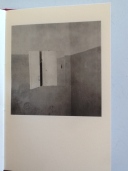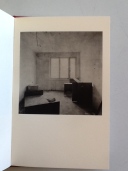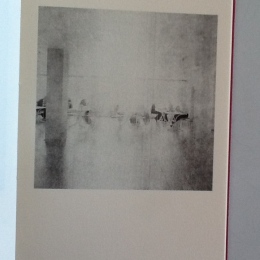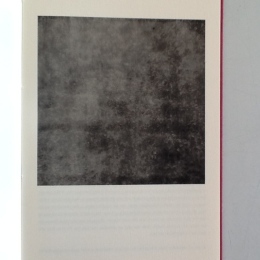From Russia with love !*
Posted: April 20, 2016 Filed under: Photobooks | Tags: Borissova, Dimitry, Germanica, Nikishin, photobooks, Photography, Russia, Russian photography, Shagin, Telkov 2 CommentsThe photographic scene in the countries of Eastern Europe is extremely prolific. It has this generosity in creating that can be perceived very often when a country emerges from the shadows of an authoritarian regime. The energy stored for years seems to free creation. I have already had occasion to speak of many works from the east and here are five more books that caught my attention recently.
May 9 by Alexey Nikishin

May 9, in Russia, is dedicated to the commemoration of the end of World War II (just one day after us!) And it is the subject of this book. But instead of commemorating the war Alexey Nikishin celebrates peace. The book begins with a few excerpts of war correspondence, some words that reflect the hell, as if, to remind us, all who have died for each of us retains freedom. Published in 2015, this book was originally the result of an assignment for the 70th anniversary of the end of the war, but rather than photographing parades of veterans, Alexey chose to show the world that has become possible thanks the victory of the allied troops.
For three years, from 2012 to 2015, Alexey has traveled the world and brought us fragments of lives. The quality of the photographs here lies in their banality, they bear witness to these daily moments that make the richness of our lives, small details, holiday photos, a couple kissing in a long sequence of three photographs taken like an embrace, turning around the couple in an improvised ballet, three views, three seconds of an eternal scene. Each photo is meticulously captioned with the date, time and place as if to affirm a reality which one could doubt, almost images to post on social networks, whose imperfections reflect the reality.
Hardcover, 21 x 24 cm, 72 pages, 30 colour photographs, text in a leaflet in English, Russian, German, French, Dutch, Chinese, Japanese. First published in Russian in 2015, second edition (first English edition) of 30 copies signed and numbered, published in 2016.
http://alexeynikishin.com/books/may9/
The journals, by Alexey Nikishin and Anton Shagin

The journals is an experience in two voices, or to better say, two scriptures: the first, Alexey’s one is photographic, the second, Anton’s one is in prose. The journal which will become the journals tells us three years of the relatioship between these two friends. It all started when Alexey glued some of his early black and white pictures, in a notebook that was handed to Anton, the latter has kept it with him, annotating with poems, according to his moods and desires. The journal has evolved, it stopped, was found again. There have been additions, withdrawals, gaps appeared… and it lasted three years. How then could one tell this experience, how a book could depict a project, together with its evolution, and not just showing the outcome ?
In this book, we came across a woman, swans and other patterns that come as chanting the same repeating words. The layout leaves space, the photos are small as to prevent us from giving them too much importance ; whites take their place. White, not as an empty space but rather a break. White in a book, it is like the silence on the radio, it’s scary, but well used, it is superb! In the end, the shape is very beautiful, the three books are glued, one passes from one to the next by the touch of the thickness of the cover. The chapters are marked, history reinvents itself … this book talks about the passing of time … and a little of ourselves.
Softcover, 17,8 x 24 cm; 132 pages; 90 black and white and colour photos, text in a leaflet in English, Russian, German, French, Dutch, Chinese, Japanese. First published in Russian in 2015, first English edition of 30 copies signed and numbered, published in 2016.
http://alexeynikishin.com/books/thejournals/
iPhonographique, by Alexey Nikishin and Valeria Gai Germanica

Alexey loves combine photography and writing. This time, he worked with the Russian director Valeria Gai Germanica. In the title is understood that the subject touches the “new photography” as practiced with smartphones. After years of a silver traditional photography in black and white, Alexey discovered the joys of “instant” colourful photography. Frenzy of social networks, publications on Instagram, how many followers ? How many likes ? Two people interact, the two combined texts and photos, of Valeria and Alexey, to create a narrative about the weird ways of living, loving and suffering.
When you read a text, images appear in your mind; when we see pictures, a story is invented, too, in our heads. This book is the coincidence of the two. More than a description of one by the other, we are witnessing here an added value, a synergistic effect, an invented sense that remains nevertheless opposable to a alternate reading. It’s like a gigantic stage of life itself: every life is Shakespearean … and every day, we put our daily life on the scene of social networks!
Softcover, 15 x 20 cm, 42 Pages,, French Folding, Japanese Binding; 34 colour photos, text in a leaflet in English, Russian, German, French, Dutch, Chinese, Japanese. First published in Russian in 2015, first English edition of 30 copies signed and numbered, published in 2016.
http://alexeynikishin.com/books/iphonographique/
Dimitry, by Julia Borissova

There are myths in the Russian history and Dimitry is one of them. Dimitry was the youngest son of Ivan the Terrible. He died mysteriously with cut throat, that was enough for the myth to come to life. For me, these names instantly summon famous names, like Eisenstein (Ivan the Terrible), or Pushkin (Boris Godunov, reinterpreted later by Mussorgsky), two authors who have interpreted this part of Russian history; but we also feels appear in the background the shade of Roland Barthes, particularly with his book “Mythologies” depicting the process of the creation of the myth. How an event can induce doubts or hopes? What about the part of history it creates, it recomposes? How the facts are twisted by the reading of a people or by its leaders? Dimitry’s story is a striking example, including his canonization by the Russian Orthodox church. This book by Julia Borissova is superb as are all those she already produced herself, handmade crafted.
A narration made of collages takes us through the Eternal Russia, images mingling to become timeless. We follow the ghost of Dimitry in the Russian countryside, he moves like a shadowy icon bearer (one thinks of course also to Andrei Rublev). It’s an oniric journey with no goal, just an imprecise souvenir floating like a dream. We try to appropriate the story to better tell it at our turn, enriching the myth ! The book can be read as an investigation, as is every work of a historian, looking for traces and details. Each society rewrote the history according to its modernity, one who is adored one day, becomes despised the day after, and so is built the myth of the hero. Julia Borissova continues her investigation without us deliver the key… One will also see a “prophetic” rooster through the pages which reminds us to the tale by Pushkin, more known from Rimsky Korsakov’s opera in XIXth century : The Golden Cockerel whose theme was the fall of the Tsarism (premonition of the October Revolution) which finds here its metaphoric sense with the murder of the Tsarevich, heir and symbol of the violent excesses committed during the reign of Ivan the Terrible. One of the finest books published this year, each page is an icon!
Artist book self published in 2016, 14,5 x 19 cm / Die Cut Hardcover, handmade binding / 88 pages. First Edition of 100 signed and numbered copies.
http://juliaborissova.ru/Julia_Borissova_PhotoSite/06.html
Artless confessions, by Fyodor Telkov

This last small book takes us back to our childhood. A school notebook of fine paper, protected by a flexible plastic cover. Plain blue, with lines to write his name in hand on the cover. For six years, Fyodor was interested in the most neglected classrooms, especially for a special feature: the graffiti left by students. Some classrooms have a lower maintenance than others and tables accumulate memories, like palimpsests Classrooms are austere, but when approaching tables, life arises. We discover, here, what could be considered as a aesthetic mix of primitive and contemporanian expression.
It is fascinating to discover the universality of these graffiti. Around the world, the subjects are the same. We do not understand the native language, but the patterns are recognizable, flowers, houses, people, signs and symbols as: peace, war. The trace of the language courses, writings in English or German; the adolescent emotions, sex, religion, chivalry, but also some unrecognizable drawings, just a wandering hand on the table, curves and bold and scarifications. Some drawings are naive, others more structured, and some become exquisite corpses reproducing a transgenerational imagination. We stop on the drawings and begin to dream, we would like to take a pencil to add our own trace, our mind wanders and moves away from the classroom, amongst Cypress Hill and Wu Tang bands, teenage dreams seem to be universal…
Self published softcover book, published in 2015. Digital printing, 17 x 20,5 cm, 32 colour photos. 30 copies signed and numbered.
http://store.fotodepartament.ru/shop/fyodor-telkov-artless-confessions
* You may notice that I am an old fan of early James Bond films starring Sean Connery.
Almost Bari, by Mara Dani
Posted: April 10, 2016 Filed under: Uncategorized Leave a commentTake a guide book and this is how it will be spoken of Bari: both economic and cultural place, this university town has a long history and a charming old historical center. Take the time to discover the front door of Puglia, to walk its streets especially at the hour of the passeggiata. For me, I have mainly heard of Bari as a gateway for North African immigrants, more known during riots in 2011. It tells how much the connotation took precedence over the denotation.

Mara Dani lives in Bari where she teaches English. She has also developed in recent years an interest in photography which she used to realize a systematic and methodical exploration of the city of Bari. To complete the connotation, the idea of Italian photography convenes instantly two famous names : Gabriele Basilico, undisputed master of architectural photography and Michelangelo Antonioni, undisputed master of boring peri-urban desolate environments. These two influences are found in the work of Mara Dani : a highly architected approach of the urban structure, alternating pictures, shot from above showing the typology of urban form with views from ground level that takes us erratically to one neighborhood to another.
With this work, Mara urges us to follow her and to get lost with her in the empty streets. Spaces are designed for cars and atmospheres are far from those of downtown (which I do not know), far from the hubbub and the linguistic frenzy that inhabits the films of Italian neorealist cinema. We are in contemporary Italy, which, like every big city has been urbanized frantically in the second half of the twentieth century. This city is a port city with a high density of population, and Bari is like all our western cities, including this seen before building or piece of wall. Only vegetation, or an earthenware retail attests that we are in the South… and then, suddenly, the turning of a page, a photo of the Istituto per le case popolari… this building finally reassures us, it corresponds to our preconceived image of Italy.
Throughout these pages, Mara Dani talks about contemporary issues such as urban landscapes, post industrial forsaken territories, resilience, conurbation, urban transportation … It is both the backstage of the city, and the everyday banality of a city life, all these locations made of spaces we cross every day without noticing, sometimes without even looking up. They evolve back and forward without anyone noticing. We well remember that here, in another time, there was a field, but don’t know since when the latter disappeared. The city is built like a gigantic palimpsest, each layer superimposed on the previous one, while erasing details. Our memory is diluted and only a few old postcards attest about our grandparents’ stories.
Mara’s look on her city remains always endearing, it takes us away from the waves of tourists who have invaded the historical city center. No selfies in these sets, there remains only the authenticity of a growing population to house at all costs. The beautiful title, itself, confirms this statement with both the accuracy and the vagueness of ambiguity : almost Bari.
Hardcover book, 16 x 21,5 cm, 92 pages, 77 black and white photos, foreword by Gian Luigi Sylos Labini and Alessandro Cirillo. 300 copies signed and numbered.
More info : http://www.maradani.it/recent-works/almost-bari/
And by the way, talking about contemporanean landscapes and Antonioni, you should also consider the beautiful Ravenna by Gerry Johansson. Ravenna was the location of the film « The red desert ».






















































































































